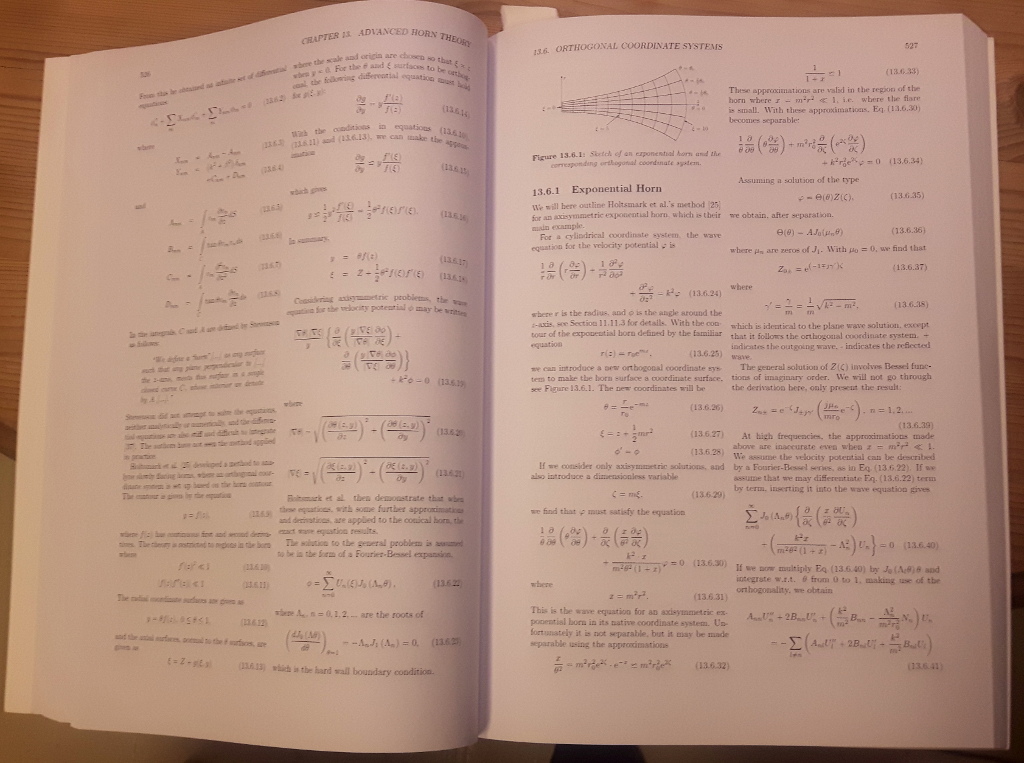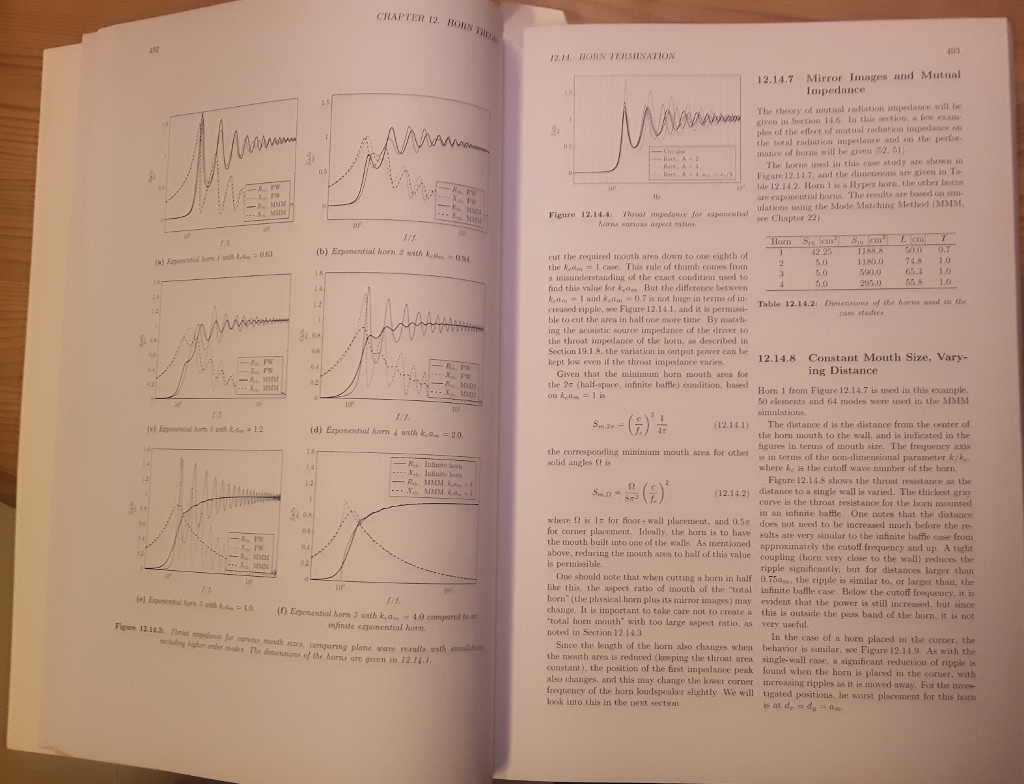Some sneak peeks from pages of the book are being prepared. I have a few shots from the theory part here that might discourage some people, but a random page or two out of the theory doesn't really say enough about how we have wanted to present the most difficult material in the book. I therefore felt like sharing some thoughts on this.

The math does get involved, things do get complex. Bjørn and I have discussed quite a bit the problems of learning and teaching this theory. I argued that people having trouble following the math (as I myself often do) would benefit hugely from graphs representing the relationships and characteristics that the mathematical theory describes. I have always loved the best horn theory by Olson because of the hugely informative figures, graphs and nomograms. Anything that illustrates relationships is always useful. A lot of the characteristics and basic mechanisms and relationships can be represented well graphically. Bjørn of course agreed to this, and used some of his software toolkit to produce a large number of very lucid graphs. I some times requested graphs that I have always wanted to see, and Bjørn made them. Some graphics have been produced based on data from other people's studies. Some fairly novel types of graphic representations introduced by other authors are also included. One of the things computers are super great at is producing nice graphics from good data. We love good graphs and a lot of them made it into the book. So we are quite proud of the graphics and think that its usefulness in the very substantial theory part of the book will be appreciated.

We have had discussions about horns and horn theory from time to time for more than two decades with a lot of different people, and with each other. It often becomes painfully clear that a lack of a common vocabulary and terminology can hugely complicate a fruitful discussion. We had to introduce some theory and terms in the history part of the book, "ahead of" the theory. Necessarily, as we often describe engineering history at the device level, but hopefully motivating the reader to look up theory relevant to what is being discussed in the history section. Keeping up with the terminology is really essential, so pay close attention... The Glossary in the Appendix of the book may be on the brief side considering the countless terms used in the theory or even the history parts, but we do expect readers to have some foreknowledge.
Some way into a more extensive study of horn theory one ends up discussing concepts and using terms that few people are familiar with. The terminology and language to explain and discuss the theory has to adapt and expand in step with the increasing complexity of the theory. It goes without saying that good acoustic theory will have to include math, graphics and text. We thought consciously about this three element approach. Good verbal explanations, good graphs, all the relevant math. But not just that, we also try to tell the history of the theory, introducing important people who contributed to the developments, and the history of how new found theoretical insights influenced the engineering and design of systems at different points in time. Everything ends up being connected - the practical engineering and design, the theory and the history. It's also a reason for publishing this work in a single volume containing three parts devoted to each of these connected elements.
I am not sure if horn theory is the sort of thing you will most easily learn in a linear way. The book is crisscrossed with cross references bridging the three main parts of the book. I think people will get siderailed from time to time reading the book, picking up a thread in one place and posibly ending up somewhere else. I suppose we assume that most people buying the book because they want to read it and own it have some thirst for knowledge and insigths, as we did. I think the composition of the book reflects our approach to the subject - it says something about how we have mentally and intellectually pieced together our own knowledge. The book is not meant to be read linearly, but we do think the history part should be read first.
I have personally found that in spite of mostly not following the math more than superficially, it is possible to understand a lot of the theory involved here in terms of the essential concepts and their many implications. I think we all try to analyze systems when faced with them, one way or the other. It turns out to require some substantial study to recognize all the factors involved in these systems and the relationships between them, how mechanisms interact and function etc. for the fuller analysis. I hope it will prove possible for people to get reasonably up to speed with essential elements of the theory if they have a true ambition to learn something. If you can follow the math, that too has been worked on extensively and proof read by several able people and will add greatly to the value of the theory. But again, with Bjørn's explaining skills and familiarity with the theory along with a huge number of great graphs and diagrams, I think the utmost effort has been made to make the theory as accessible as possible to as many different people as possible. It will seem extremely overwhelming to some - because never before has this much horn speaker theory been put into a single volume. But the theory also covers drivers, distortion, crossovers, sound radiation principles and other relevant subjects. Still, the horn theory itself is about as complete as it gets for a textbook. Nothing in the book has been tested on humans before (except the proof readers and a few friends of ours) so we can't be sure just how it will be received out there, but I think we have some reasons to be optimistic.
A lot of the best theory out there describes methods of optimising some thing or other. We have tried to connect the theory of the transducer-horn systems to the theory of distortion in transducers and horns, and to insights into sound perception, as well as to room acoustics and other interesting factors. We have also included "High-Quality" as the "pre-title" of the book and try to discuss factors recognized to be important to good quality reproduction. The history of horn speaker engineering is obviously also a lot about sound quality and how requirements have changed, and also about studies investigating quality as judged by the ear. We find that they were very good at this back in the 1920s and 1930s. They produced very good sounding components back then, partly because they often let the ear be the judge, or even amended the theory with certain implications of findings from listening tests.
The study of quality related factors in the systems involved of course had to be covered, and as DIY audio enthusiasts we are always looking for approaches to improved sound quality, or even more generally - the best possible listening experiences. We hope that the book provides some interesting clues and ideas to help people along the way. The theory doesn't point to right or wrong, but it can say a great deal about the nature of compromises and tradeoffs involved in speaker systems. It will also be apparent that different schools of engineering have existed and still exist in the field of horn speakers and their derivatives.

Bjørn says he practiced teaching technological subjects as he tried to explain electronics and such to parents and relatives in his youth. Having reiterated a lot of theoretical concepts in discussions over the years and having connected still more dots, and Bjørn of course also having studied the subject academically, discussing subject matter with co-students, professors and counselors, has developed a very good ability to explain this complex theory. In the language of a scholar, acoustician and engineer, of course. This book is hard core in many ways, but it is also the first and only book available specifically on horn speaker systems. It also does not come with an expiration date... We expect many readers to spend quite a bit of time with it.

